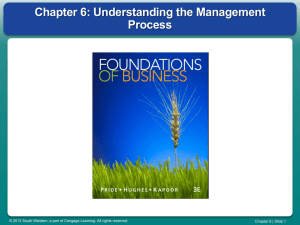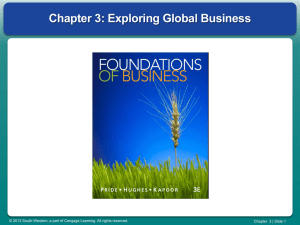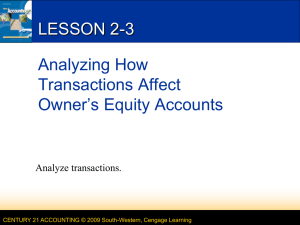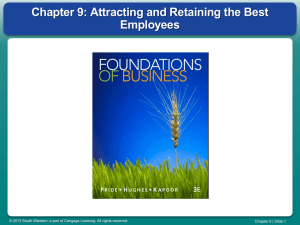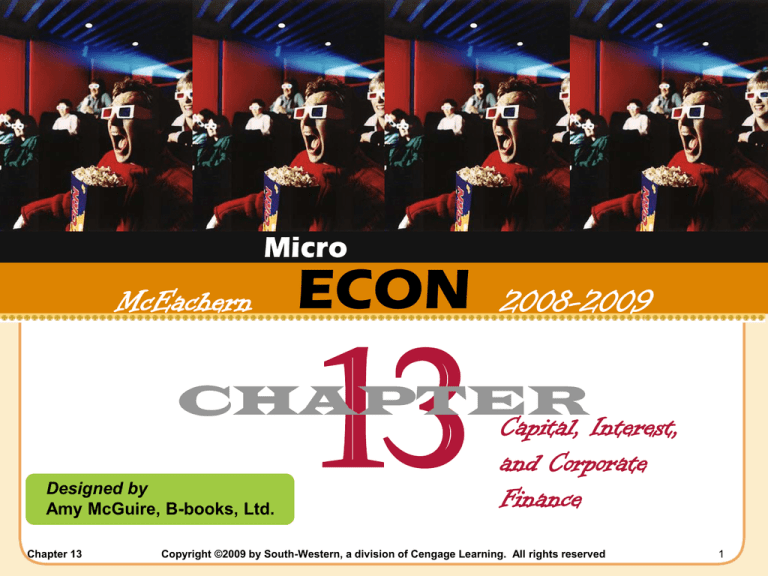
Micro
McEachern
ECON
13
2008-2009
CHAPTER
Capital, Interest,
Designed by
Amy McGuire, B-books, Ltd.
Chapter 13
and Corporate
Finance
Copyright ©2009 by South-Western, a division of Cengage Learning. All rights reserved
1
Production, Saving, and Time
Production
– Cannot occur without prior saving
– Roundabout production
• Produce capital to increase
productivity
– Requires saving
• Takes time
– Goods and services are not
available from current production
LO1
Chapter 13
Copyright ©2009 by South-Western, a division of Cengage Learning. All rights reserved
2
Consumption, Saving, and Time
LO1
Chapter 13
Consumers
– Positive rate of time preference
• Value present consumption more than
future consumption
– Willing to pay more to consume now
• Impatience
• Uncertainty
– Interest
• Reward for postponing consumption
– Interest rate
Copyright ©2009 by South-Western, a division of Cengage Learning. All rights reserved
3
LO1 Exhibit 1(a)
Marginal Rate of Return per Year on
Investment in Farm Equipment
Marginal rate of return = MRP/MRC
Chapter 13
Copyright ©2009 by South-Western, a division of Cengage Learning. All rights reserved
4
Optimal Investment
Specialization and exchange
• Purchase capital
• Borrow funds
Diminishing marginal returns from capital
Marginal rate of return on investment
– Capital’s MRP as percentage of its MRC
– Marginal benefit of investment
Market interest rate
LO2 – Opportunity cost of investing
Chapter 13
Copyright ©2009 by South-Western, a division of Cengage Learning. All rights reserved
5
LO2 Exhibit 1(b)
Interest rate (percent)
Marginal Rate of Return per Year on
Investment in Farm Equipment
40
Marginal rate
of return
32
24
16
8
0
$10,000
$20,000
$30,000
$40,000
$50,000
$60,000
Investment
Marginal rate of return curve: line segments showing the relationship between the market interest rate
and the amount invested in farm equipment. This curve shows the farmer’s demand for investment.
Chapter 13
Copyright ©2009 by South-Western, a division of Cengage Learning. All rights reserved
6
Optimal Investment
Maximize profit
– Increase investment as long as marginal
rate of return > market interest rate
Demand for investment
– Derived demand
– Marginal rate of return curve
– Demand curve: steps down
• Diminishing marginal productivity
of capital
2
LO
Chapter 13
Copyright ©2009 by South-Western, a division of Cengage Learning. All rights reserved
7
Case Study
LO2 The Value of a Good Idea–Intellectual Property
Chapter 13
Intellectual property
Intangible assets
created by human
knowledge and ideas
Costly to produce
Once produced, can be
supplied at low cost
Copyright ©2009 by South-Western, a division of Cengage Learning. All rights reserved
8
Case Study
LO2 The Value of a Good Idea–Intellectual Property
Chapter 13
Patent
Invention, technical
advances
Copyright
Original expression of
an author, artist,
composer, computer
programming
Trademark
Unique commercial
marks and symbols
Copyright ©2009 by South-Western, a division of Cengage Learning. All rights reserved
9
Case Study
LO2 The Value of a Good Idea–Intellectual Property
Chapter 13
Enforcing property rights
Costly
Diminished incentive to create new
products
Pirated videos, music, computer games,
software
No royalties to artists
No wages to industry workers
No profits to producers, programmers
No taxes to government
Copyright ©2009 by South-Western, a division of Cengage Learning. All rights reserved
10
The Market for
Loanable Funds
LO2
Chapter 13
Demanders of loans (borrow)
– Entrepreneurs
• Start firms
• Invest in physical and intellectual capital
– Increase investment until
• Expected marginal rate of return =
market interest rate
– Households
• Present consumption
• Invest in human capital
Downward sloping D curve
Copyright ©2009 by South-Western, a division of Cengage Learning. All rights reserved
11
The Market for
Loanable Funds
LO2
Chapter 13
Demand for loanable funds
– Negative relationship
• Market interest rate
• Quantity of loans demanded
– Declining marginal rate of return on
investment
– Other things constant
• Prices of other resources
• Technology
• Tax laws
Copyright ©2009 by South-Western, a division of Cengage Learning. All rights reserved
12
The Market for
Loanable Funds
LO2
Chapter 13
Supply of loanable funds
– Banks = financial intermediaries
– Positive relationship
• Market interest rate
• Quantity of savings supplied
– Interest rate
• Reward for saving
Market interest rate
• Demand
• Supply
Copyright ©2009 by South-Western, a division of Cengage Learning. All rights reserved
13
LO2 Exhibit 2
Market for Loanable Funds
Because of the declining
marginal rate of return on capital,
the quantity of loanable funds
demanded is inversely related to
the interest rate. The equilibrium
rate of interest, 8%, is found
where D intersects the S.
An increase in demand from D
to D’ raises the equilibrium
interest rate from 8% to 9% and
increases the market quantity of
loanable funds from $100 billion
to $115 billion.
Chapter 13
Copyright ©2009 by South-Western, a division of Cengage Learning. All rights reserved
14
Why Interest Rates Differ
Risk
– The more valuable the collateral, the
lower the interest rate
Duration of the loan
– Interest rate increases with the
duration of the loan
Administration costs
– Decrease as size of the loan increases
Tax treatment
2
LO
Chapter 13
Copyright ©2009 by South-Western, a division of Cengage Learning. All rights reserved
15
LO2 Exhibit 3
Interest Rates Charged for Different Types of Loans
Interest rates are higher for
riskier loans.
Rates for home mortgages
and new cars are relatively
low because these loans are
backed up by the home or
car as collateral.
Personal loans and credit card balances face the highest rates, because these
loans are riskier – that is, the likelihood borrowers fail to repay the loans is greater
and the borrower offers no collateral.
Chapter 13
Copyright ©2009 by South-Western, a division of Cengage Learning. All rights reserved
16
LO3
Present Value and
Discounting
Present value
Current value of payment(s) to be received in
the future
Present value one year hence
Amount received one year from now
Divided by (1+interest rate)
The higher the interest rate
The more any future payment is discounted
The lower its present value
Chapter 13
Copyright ©2009 by South-Western, a division of Cengage Learning. All rights reserved
17
LO3
Present Value and
Discounting
Present value (PV) for payments in later years
Receive M dollars
t years from now
Interest rate i
M
PV
t
(1 i )
Smaller for higher t
Chapter 13
Copyright ©2009 by South-Western, a division of Cengage Learning. All rights reserved
18
LO3
Present Value and
Discounting
Present value of an income stream
Receive $100 next year, and $150 year after
next; i=5%
$100 $150
PV
$231.29
2
1.05 (1.05)
Present value of an annuity
Perpetuity – if continues indefinitely
Present value of receiving M dollars each
year forever
M
Chapter 13
i
Copyright ©2009 by South-Western, a division of Cengage Learning. All rights reserved
19
Case Study
LO3 The Million-Dollar Lottery?
Chapter 13
Win $1 million
Paid in annuities
$50,000 a year for
20 years, i=10%
Present value:
$425,700
Lump sum
Less than half
After taxes: only
27% of winnings
Copyright ©2009 by South-Western, a division of Cengage Learning. All rights reserved
20
Corporate Finance
Corporation
– Owned by stockholders
– Owns property
– Earns profit
– Sue or get sued
– Incur debt
LO4
Chapter 13
Copyright ©2009 by South-Western, a division of Cengage Learning. All rights reserved
21
Corporate Stock and
Retained Earnings
Fund investment
– Issue and sell stock
– Retain some of their profits
– Borrow
Pay
– Corporate income taxes on any profit
– Dividends to shareholders
Retained earnings
– Reinvested profit
LO4
Chapter 13
Copyright ©2009 by South-Western, a division of Cengage Learning. All rights reserved
22
Corporate Bonds
Corporations borrow
– Bank loan
– Issue and sell bonds
Bond
– Pay back a fixed sum, on
the maturity date; annual
interest payment
– Less risky
LO4
Chapter 13
Copyright ©2009 by South-Western, a division of Cengage Learning. All rights reserved
23
Securities Exchange
Securities market
– Stocks and bonds
– Secondary market for securities
• Enhance liquidity
– Hedge funds
– Determine the current value of a
corporation
– Allocate funds more readily to successful
4 firms than to firms in financial difficulty
LO
Chapter 13
Copyright ©2009 by South-Western, a division of Cengage Learning. All rights reserved
24

